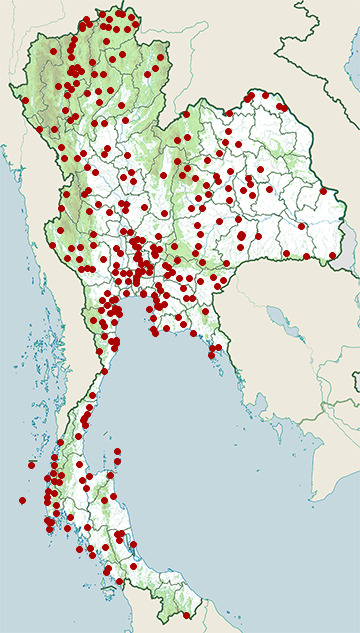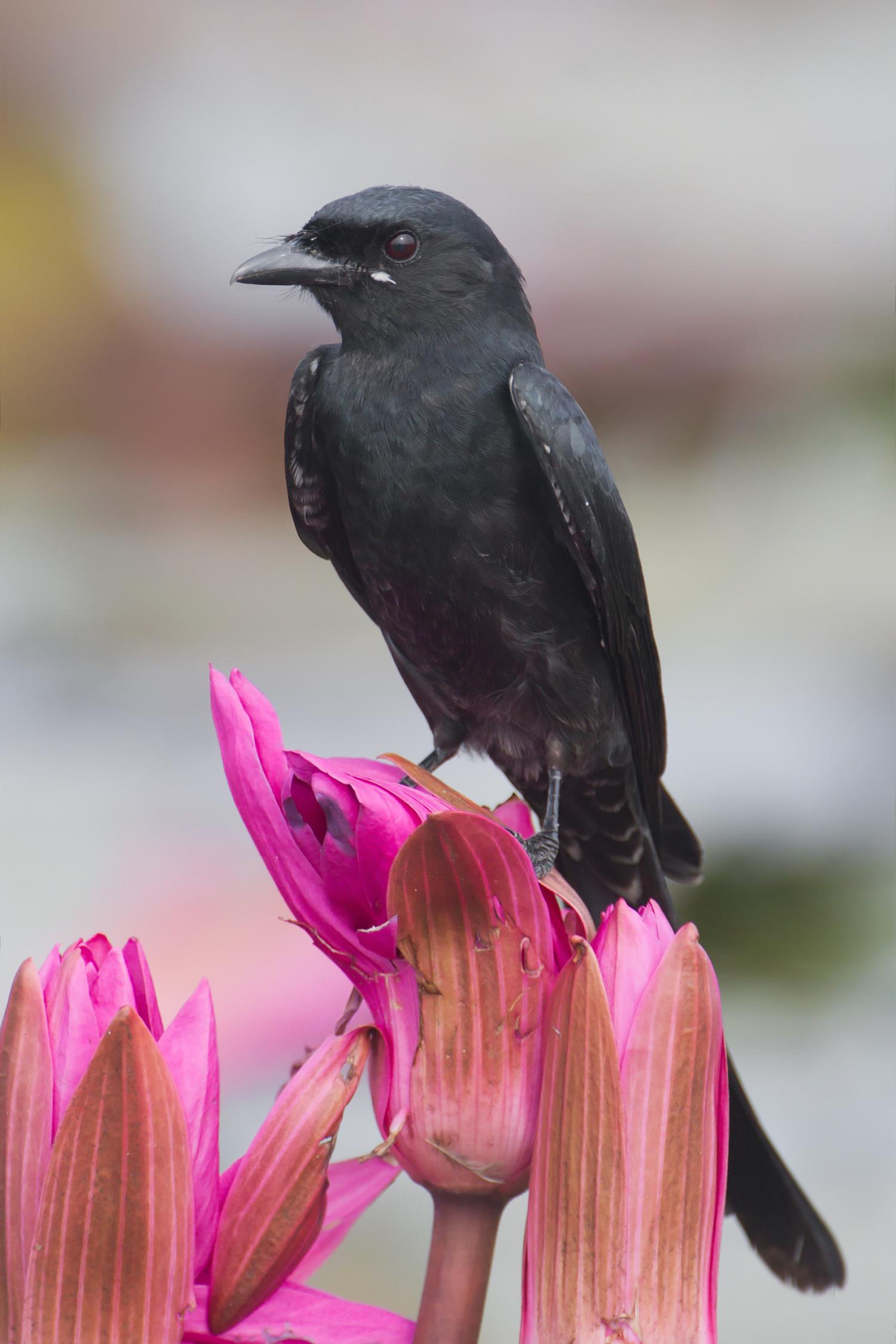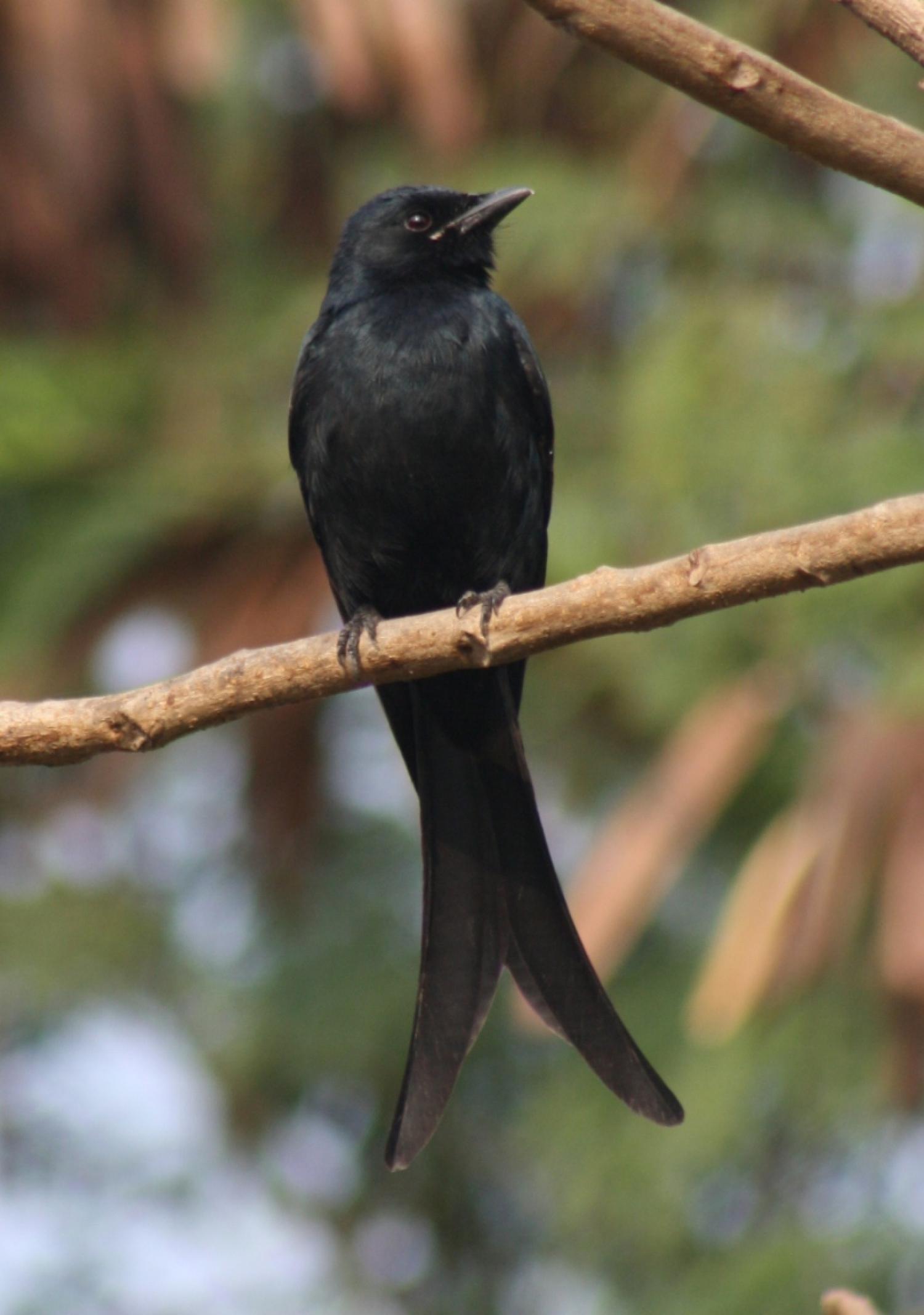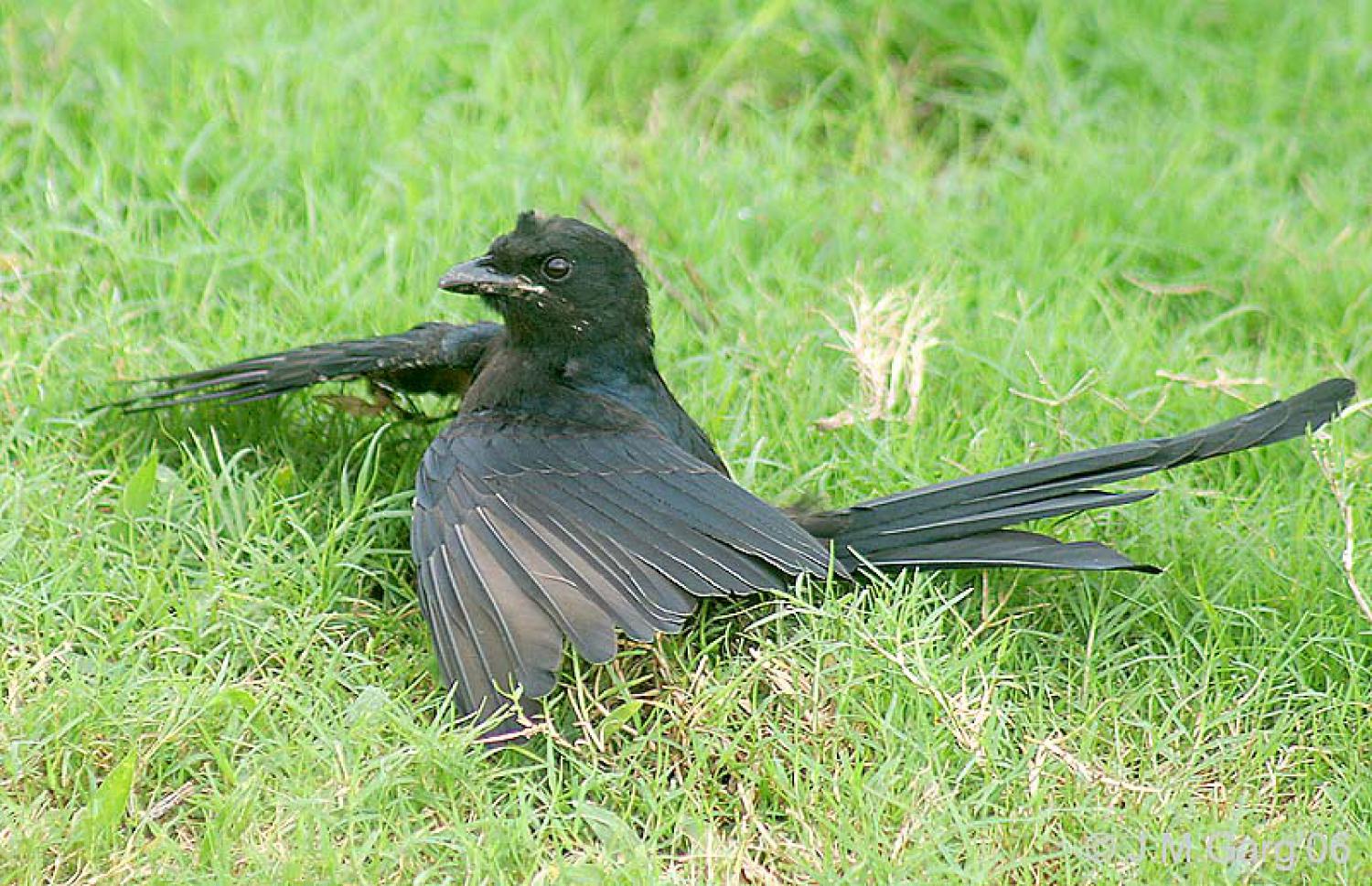Species of Thailand
Black drongo
Dicrurus macrocercus
Louis Jean Pierre Vieillot, 1817
In Thai: นกแซงแซวหางปลา
The black drongo (Dicrurus macrocercus) is a small Asian passerine bird of the drongo family Dicruridae. It is a common resident breeder in much of tropical southern Asia from southwest Iran through India, Bangladesh and Sri Lanka east to southern China and Indonesia and accidental visitor of Japan. It is an all black bird with a distinctive forked tail and measures 28 cm in length. It feeds on insects, and is common in open agricultural areas and light forest throughout its range, perching conspicuously on a bare perch or along power or telephone lines. The species is known for its aggressive behaviour towards much larger birds, such as crows, never hesitating to dive-bomb any bird of prey that invades its territory. This behaviour earns it the informal name of king crow. Smaller birds often nest in the well-guarded vicinity of a nesting black drongo. Previously grouped along with the African fork-tailed drongo (Dicrurus adsimilis), the Asian forms are now treated as a separate species with several distinct populations.
The black drongo has been introduced to some Pacific islands, where it has thrived and become abundant to the point of threatening and causing the extinction of native and endemic bird species there.
Taxonomy and systematics
The black drongo was once considered a subspecies of the fork-tailed drongo (Dicrurus adsimilis), a close relative that diverged relatively recently. The two are now considered distinct species, with the fork-tailed drongo restricted to Africa and separated from the Asian range of the black drongo.
Seven subspecies have been named but the largely contiguous populations show clinal variation and intergrade with each other. Individuals from northern India (ssp. albirictus) are larger than those from the Sri Lankan population minor while those from the peninsular India (nominate subspecies) are intermediate in size. Race cathoecus is found in Thailand, Hong Kong and China. This race has a much smaller rictal spot and the wings are dark with a greenish gloss. In southern Siam a race thai is resident, but overlaps with wintering cathoecus. Race javanus is found on the islands of Java and Bali. Race harterti found in Formosa has the tail length less than the wing.
Description
This bird is glossy black with a wide fork to the tail. Adults usually have a small white spot at the base of the gape. The iris is dark brown (not crimson as in the similar ashy drongo). The sexes cannot be told apart in the field. Juveniles are brownish and may have some white barring or speckling towards the belly and vent, and can be mistaken for the white-bellied drongo. First-year birds have white tips to the feathers of the belly, while second-years have these white-tipped feathers restricted to the vent.
They are aggressive and fearless birds, and although only 28 cm round=0.5 in length, they will attack much larger species that enter their nesting territory, including crows and birds of prey. This behaviour led to their former name of king crow. They fly with strong flaps of the wing and are capable of fast manoeuvres that enable them to capture flying insects. With short legs, they sit upright on thorny bushes, bare perches or electricity wires. They may also perch on grazing animals.
They are capable of producing a wide range of calls but a common call is a two note tee-hee call resembling that of the shikra (Accipiter badius).
Distribution and habitat
The black drongo is found predominantly in open country and usually perches and hunts close to the ground. They are mostly aerial predators of insects but also glean from the ground or off vegetation. They are found as summer visitors to northeastern Afghanistan and northern Pakistan but are residents from the Indus Valley until Bangladesh and into India and Sri Lanka. Some populations show seasonal movements that are poorly understood while populations in Korea are known to be migratory. The black drongo can be found in savanna, fields, and urban habitats.
Black drongos were introduced just before the Second World War from Taiwan to the island of Rota to help in the control of insects. It is believed that they dispersed over the sea to the island of Guam in the 1950s. By 1967, they were the fourth most commonly seen birds in roadside counts on Guam and are today the most abundant bird there. Predation by and competition from black drongos have been suggested as factors in the decline of endemic bird species such as the Rota bridled white-eye and the Guam flycatcher.
Food and foraging
Black drongos become active very early at dawn and roost later than many other birds. They feed mainly on insects such as grasshoppers, cicadas, termites, wasps, bees, ants, moths, beetles and dragonflies. They sometimes fly close to tree branches, attempting to disturb any insects that may be present. They congregate in fields being ploughed, picking up exposed caterpillars and beetle grubs. As many as 35 birds have been seen at such congregations. They are also attracted to fires in scrub and grasslands habitats where insects are disturbed. They appear to avoid flies. They associate with common mynas, cattle egrets and other birds that share a similar diet and habitat. Drongos benefit from this association and are more successful in their foraging. There is only partial overlap in the insect prey sought by mynas and drongos although in rare instances the drongos may rob prey from mynas. It is said that they imitate the call of the shikra so as to put mynas to flight and then to steal prey. Similar behaviour, using false alarm calls, has been noted in the fork-tailed drongo. There are some cases of the black drongo preying on small birds, reptiles, or maybe even bats. It has been suggested that they may feed on birds more intensively on migration. An individual on a migratory stop-over island in Korea caught several birds one after the other, killing them by striking at the back of the head and neck and feeding selectively on parts, especially the brain. They have also been on occasion seen feeding on fish Flowers of trees such as Erythrina and Bombax may be visited for water and nectar and they are sometimes known to feed on grains. They are only rarely known to take larger arthropods such as scorpions and centipedes. They feed on milkweed butterflies that are often avoided by other predators and are known to feed late in the evening or night, often on insects attracted to artificial lights.
Nesting and breeding
Black drongos breed mainly in February and March in southern India, and until August in other parts of the country. Males and females sing in the mornings during the breeding season. Courtship can include aerobatic chases and they may lock their wings and beaks together, with the pair sometimes falling to the ground. Displays may be made on the ground. Pair bonds are retained for a whole breeding season. The nest is a cup made with a thin layer of sticks placed in the fork of branch, and is built in a week by both the male and female. Eggs are laid close to the first rains in April. The usual clutch is three or rarely four eggs laid in a cup nest placed in the fork of an outer branch of tree. Large leafy trees such as the jackfruit are preferred. The eggs are pale cream to red with spots and markings and are 26 mm long and 19 mm wide. The eggs are incubated by both parents and hatch after 14 to 15 days. Nestlings are brooded for the first five days, after which the young are capable of maintaining a fairly constant body temperature. A second clutch may be laid if the first is destroyed. Nests are sometimes built in telephone poles. A nesting territory of 0.003 to 0.012 km2 (0.3 to 1.2 hectares) is maintained.
Helpers, offspring from the previous brood, have sometimes been noted to assist in feeding the fledglings at the nest of their parents. Cases of brood parasitism by the Asian koel have been noted. An average breeding success of 44% has been noted with the main cause of fledgling mortality being shortage of insect food which in turn was dependent on rainfall.
Mobbing and proximity nesting
Their habit of driving away predators from near their nests is believed to encourage other birds such as orioles, doves, pigeons, babblers, and especially bulbuls, to nest in the vicinity. In one study 18 of 40 nests had red-vented bulbuls nesting within 10 m. An abnormal case of interspecific feeding with a red-vented bulbul feeding the chicks of a black drongo at their nest has been recorded.
They are so aggressive that they may sometimes land on large birds of prey and peck them when mobbing. It has been suggested that the Asian drongo-cuckoo (Surniculus lugubris) has evolved to mimic this species. The intensity of mobbing predators was studied in Java and observations showed that there was a significant increase in mobbing, during the nesting season, of some predators such as the Javan hawk-eagle but the black eagle, a nest predator is mobbed with equal intensity in all seasons. It has been suggested that this strategy may avoid giving away the location of nests during the breeding season.
Growth and development
Young birds have a yellowish-red gape. The feather follicles appear on the fourth day and pin feathers emerge after a week. Nestlings increase in weight steadily until they are 12 days old. The eyes open on the eighth day, the iris reddish-black while the gape turns red. The young leave the nest after about 16 to 20 days after hatching. They do not have the fork in the tail until three weeks. The parents continue to feed and protect them for a month. Young birds may beg for food for longer, but are often ignored or chased away by the adults. Birds reach breeding condition in about two years.
Play behaviour has been observed with birds dropping a leaf in the air and catching it in mid-air and these may possibly help young birds acquire aerobatic skills.
In southern India, they moult their feathers from June to October. The wing moult begins in July with the first primary and proceeds towards the tenth. Secondaries are replaced from August after the primaries are at the third quill. The secondary moult is not orderly, the 8th and 7th being dropped earlier than the rest. The tail feathers are moulted centrifugally. Seasonal colour changes in the testicular tissues are caused by variation in melanin synthesis, with the dark pigmentation being lost during the breeding season.
Parasites and diseases
Many ectoparasitic bird lice (Myrsidea spp. and Menacanthus spp.), endoparasitic cestodes and nematodes have been described from this species. However no predators or diseases are significant factors in adult mortality.
Relation to humans
Their habit of preying on bees makes them a nuisance to bee-keepers, but farmers attract them to their fields using artificial perches in fields to encourage them to feed on pest insects.
In culture
Being common, they have a wide range of local names. The older genus name of Buchanga was derived from the Hindi name of Bhujanga. Other local names include "srigunting hitam" in Indonesia, Thampal in Pakistan, Gohalo/Kolaho in Baluchistan, Kalkalachi in Sindhi, Kotwal (=policeman) in Hindi; Finga in Bengali; Phenshu in Assamese; Cheiroi in Manipuri; Kosita/ Kalo koshi in Gujarati; Ghosia in Marathi; Kajalapati in Oriya; Kari kuruvi (=charcoal bird), Erettai valan (=two tail) in Tamil; Passala poli gadu in Telugu; Aanaranji (=elephant snatcher) in Malayalam; Kari bhujanga in Kannada and Kalu Kawuda in Sinhalese. The soliga people do not differentiate this and the bronzed drongo, both being known as karaḷi but the greater racket-tailed drongo is called dodda karaḷi(or large karaḷi). A superstition in central India is that cattle would lose their horn if a newly fledged drongo alighted on it. It is held in reverence in parts of Punjab in the belief that it brought water to Husayn ibn Ali, revered by Shī‘a Muslims.
This article uses material from Wikipedia released under the Creative Commons Attribution-Share-Alike Licence 3.0. Eventual photos shown in this page may or may not be from Wikipedia, please see the license details for photos in photo by-lines.
Category / Seasonal Status
Wiki listed status (concerning Thai population): Resident and winter visitor
BCST Category: Recorded in an apparently wild state within the last 50 years
BCST Seasonal statuses:
- Resident or presumed resident
- Non-breeding visitor
Scientific classification
- Kingdom
- Animalia
- Phylum
- Chordata
- Class
- Aves
- Order
- Passeriformes
- Family
- Dicruridae
- Genus
- Dicrurus
- Species
- Dicrurus macrocercus
Common names
- Thai: นกแซงแซวหางปลา
Synonyms
- Bhuchanga albirictus
- Buchanga atra,
Conservation status

Least Concern (IUCN3.1)
Photos
Please help us review the bird photos if wrong ones are used. We can be reached via our contact us page.
Range Map

- Amphawa District, Samut Songkhram
- Ao Phang-Nga National Park
- Aranyaprathet District, Sa Kaeo
- Ban Bueng District, Chonburi
- Ban Hong Non-Hunting Area
- Ban Laem District, Phetchaburi
- Ban Lat District, Phetchaburi
- Ban Lueam District, Nakhon Ratchasima
- Ban Phai District, Khon Kaen
- Ban Pho District, Chachoengsao
- Ban Phraek District, Phra Nakhon Si Ayutthaya
- Ban Sang District, Prachinburi
- Bang Ban District, Phra Nakhon Si Ayutthaya
- Bang Lamung District, Chonburi
- Bang Len District, Nakhon Pathom
- Bang Pa In District, Phra Nakhon Si Ayutthaya
- Bang Pahan District, Phra Nakhon Si Ayutthaya
- Bang Pakong District, Chachoengsao
- Bang Phra Non-Hunting Area
- Bang Pu Recreation Centre
- Bang Saphan Noi District, Prachuap Khiri Khan
- Bangkok Province
- Borabue District, Maha Sarakham
- Bueng Boraped Non-Hunting Area
- Bueng Khong Long Non-Hunting Area
- Chae Hom District, Lampang
- Chaiya District, Surat Thani
- Chaiyo District, Ang Thong
- Chaloem Phra Kiat District, Saraburi
- Chatturat District, Chaiyaphum
- Chiang Dao District, Chiang Mai
- Chiang Dao Wildlife Sanctuary
- Chiang Khan District, Loei
- Chiang Khong District, Chiang Rai
- Chiang Saen District, Chiang Rai
- Chum Ta Bong District, Nakhon Sawan
- Doi Inthanon National Park
- Doi Lang
- Doi Lo District, Chiang Mai
- Doi Pha Hom Pok National Park
- Doi Phu Kha National Park
- Doi Saket District, Chiang Mai
- Doi Suthep - Pui National Park
- Doi Tao District, Chiang Mai
- Don Chedi District, Suphan Buri
- Dong Kheng Forest Park
- Erawan National Park
- Fang District, Chiang Mai
- Hala-Bala Wildlife Sanctuary
- Hang Chat District, Lampang
- Hat Chao Mai National Park
- Hat Wanakon National Park
- Hat Yai District, Songkhla
- Hua Hin District, Prachuap Khiri Khan
- Huai Chorakhe Mak Reservoir Non-Hunting Area
- Huai Kha Khaeng Wildlife Sanctuary
- Huai Krachao District, Kanchanaburi
- Huai Sala Wildlife Sanctuary
- Huai Talat Reservoir Non-Hunting Area
- In Buri District, Sing Buri
- Kabin Buri District, Prachinburi
- Kaeng Khoi District, Saraburi
- Kaeng Khro District, Chaiyaphum
- Kaeng Krachan District, Phetchaburi
- Kaeng Krachan National Park
- Kamphaeng Saen District, Nakhon Pathom
- Kanthararom District, Sisaket
- Kantharawichai District, Maha Sarakham
- Kapong District, Phang Nga
- Kaset Sombun District, Chaiyaphum
- Khanom District, Nakhon Si Thammarat
- Khao Ang Rue Nai Wildlife Sanctuary
- Khao Dinsor (Chumphon Raptor Center)
- Khao Khiao - Khao Chomphu Wildlife Sanctuary
- Khao Kradong Forest Park
- Khao Laem National Park
- Khao Lak - Lam Ru National Park
- Khao Luang National Park
- Khao Nang Phanthurat Forest Park
- Khao Phra - Bang Khram Wildlife Sanctuary
- Khao Phra Thaeo Wildlife Sanctuary
- Khao Phra Wihan National Park
- Khao Sam Roi Yot National Park
- Khao Sanam Prieng Wildlife Sanctuary
- Khao Soi Dao Wildlife Sanctuary
- Khao Sok National Park
- Khao Yai National Park
- Khao Yoi District, Phetchaburi
- Khemarat District, Ubon Ratchathani
- Khlong Luang District, Pathum Thani
- Khlong Saeng Wildlife Sanctuary
- Khok Sung District, Sa Kaeo
- Khon San District, Chaiyaphum
- Khuan Khanun District, Phatthalung
- Khun Chae National Park
- Khun Phawo National Park
- Khun Tan District, Chiang Rai
- Khung Kraben Non-Hunting Area
- Khura Buri District, Phang Nga
- Klaeng District, Rayong
- Ko Chang National Park
- Ko Lanta National Park
- Ko Libong
- Ko Phra Thong
- Ko Samui District, Surat Thani
- Ko Sichang District, Chonburi
- Kui Buri National Park
- Kumphawapi District, Udon Thani
- Kut Thing Non-Hunting Area
- La-ngu District, Satun
- Laem Ngop District, Trat
- Laem Pak Bia
- Laem Son National Park
- Lam Nam Kok National Park
- Lan Sang National Park
- Li District, Lamphun
- Mae Ai District, Chiang Mai
- Mae Chan District, Chiang Rai
- Mae Fa Luang District, Chiang Rai
- Mae Mo District, Lampang
- Mae Moei National Park
- Mae Ping National Park
- Mae Rim District, Chiang Mai
- Mae Sot District, Tak
- Mae Taeng District, Chiang Mai
- Mae Tha, Lampang District, Lampang
- Mae Wong National Park
- Mancha Khiri District, Khon Kaen
- Mu Ko Chumphon National Park
- Mu Ko Phetra National Park
- Mueang Buriram District, Buriram
- Mueang Chachoengsao District, Chachoengsao
- Mueang Chaiyaphum District, Chaiyaphum
- Mueang Chiang Mai District, Chiang Mai
- Mueang Chiang Rai District, Chiang Rai
- Mueang Chonburi District, Chonburi
- Mueang Chumphon District, Chumphon
- Mueang Kalasin District, Kalasin
- Mueang Kamphaeng Phet District, Kamphaeng Phet
- Mueang Kanchanaburi District, Kanchanaburi
- Mueang Khon Kaen District, Khon Kaen
- Mueang Krabi District, Krabi
- Mueang Lampang District, Lampang
- Mueang Lamphun District, Lamphun
- Mueang Lopburi District, Lopburi
- Mueang Maha Sarakham District, Maha Sarakham
- Mueang Nakhon Nayok District, Nakhon Nayok
- Mueang Nakhon Pathom District, Nakhon Pathom
- Mueang Nakhon Ratchasima District, Nakhon Ratchasima
- Mueang Nakhon Sawan District, Nakhon Sawan
- Mueang Nan District, Nan
- Mueang Nong Khai District, Nong Khai
- Mueang Nonthaburi District, Nonthaburi
- Mueang Pan District, Lampang
- Mueang Pathum Thani District, Pathum Thani
- Mueang Phang Nga District, Phang Nga
- Mueang Phatthalung District, Phatthalung
- Mueang Phayao District, Phayao
- Mueang Phetchabun District, Phetchabun
- Mueang Phetchaburi District, Phetchaburi
- Mueang Phichit District, Phichit
- Mueang Phitsanulok District, Phitsanulok
- Mueang Phuket District, Phuket
- Mueang Prachinburi District, Prachinburi
- Mueang Ranong District, Ranong
- Mueang Ratchaburi District, Ratchaburi
- Mueang Rayong District, Rayong
- Mueang Sa Kaeo District, Sa Kaeo
- Mueang Samut Sakhon District, Samut Sakhon
- Mueang Samut Songkhram District, Samut Songkhram
- Mueang Saraburi District, Saraburi
- Mueang Satun District, Satun
- Mueang Sukhothai District, Sukhothai
- Mueang Suphanburi District, Suphan Buri
- Mueang Surat Thani District, Surat Thani
- Mueang Surin District, Surin
- Mueang Tak District, Tak
- Mueang Trat District, Trat
- Mueang Udon Thani District, Udon Thani
- Mueang Uttaradit District, Uttaradit
- Nam Nao National Park
- Nam Phong National Park
- Namtok Sam Lan National Park
- Non Din Daeng District, Buriram
- Non Sang District, Nong Bua Lamphu
- Non Thai District, Nakhon Ratchasima
- Nong Bong Khai Non-Hunting Area
- Nong Prue District, Kanchanaburi
- Nong Song Hong District, Khon Kaen
- Nong Suea District, Pathum Thani
- Nong Thung Thong Non-Hunting Area
- Nong Waeng Non-Hunting Area
- Nong Ya Plong District, Phetchaburi
- Nong Yai Area Development Project Under Royal Init
- Omkoi Wildlife Sanctuary
- Pa Sang District, Lamphun
- Pai District, Mae Hong Son
- Pak Chong District, Nakhon Ratchasima
- Pak Khat District, Bueng Kan
- Pak Kret District, Nonthaburi
- Pak Phli District, Nakhon Nayok
- Pak Thale
- Pak Tho District, Ratchaburi
- Pak Thong Chai District, Nakhon Ratchasima
- Pang Sila Thong District, Kamphaeng Phet
- Pathio District, Chumphon
- Pha Daeng National Park
- Phaisali District, Nakhon Sawan
- Phan District, Chiang Rai
- Phanat Nikhom District, Chonburi
- Phatthana Nikhom District, Lopburi
- Phayuha Khiri District, Nakhon Sawan
- Phi Phi Islands
- Phimai District, Nakhon Ratchasima
- Pho Prathap Chang District, Phichit
- Phra Nakhon Si Ayutthaya District, Phra Nakhon Si Ayutthaya
- Phu Chong Na Yoi National Park
- Phu Foi Lom National Park
- Phu Khiao Wildlife Sanctuary
- Phu Langka National Park
- Phu Luang Wildlife Sanctuary
- Phu Toei National Park
- Phu Wiang National Park
- Phunphin District, Surat Thani
- Phutthamonthon District, Nakhon Pathom
- Pran Buri District, Prachuap Khiri Khan
- Pran Buri Forest Park
- Ramkhamhaeng National Park
- Rattanawapi District, Nong Khai
- Sai Noi District, Nonthaburi
- Sai Yok District, Kanchanaburi
- Sai Yok National Park
- Sakaerat Environmental Research Station
- Salak Pra Wildlife Sanctuary
- Salawin National Park
- Samae San Island
- Samut Prakan Province
- San Sai District, Chiang Mai
- Sanam Bin Reservoir Non-Hunting Area
- Sanam Chai Khet District, Chachoengsao
- Sankhaburi District, Chainat
- Santi Suk District, Nan
- Sathing Phra District, Songkhla
- Sattahip District, Chonburi
- Si Maha Phot District, Prachinburi
- Si Racha District, Chonburi
- Si Satchanalai District, Sukhothai
- Si Satchanalai National Park
- Si Sawat District, Kanchanaburi
- Si Thep District, Phetchabun
- Similan Islands
- Sirinat National Park
- Song Phi Nong District, Suphan Buri
- Sri Nakarin Dam National Park
- Sri Phang-nga National Park
- Suk Samran District, Ranong
- Sung Men District, Phrae
- Surin Islands
- Takua Pa District, Phang Nga
- Taphan Hin District, Phichit
- Tha Chang District, Sing Buri
- Tha Sala District, Nakhon Si Thammarat
- Tha Takiap District, Chachoengsao
- Tha Wung District, Lopburi
- Tha Yang District, Phetchaburi
- Thai Mueang District, Phang Nga
- Thalang District, Phuket
- Thale Noi Non-Hunting Area
- Than Sadet - Koh Pha-Ngan National Park
- Thanyaburi District, Pathum Thani
- Thao Kosa Forest Park
- Thap Lan National Park
- Thap Than District, Uthai Thani
- Thawat Buri District, Roi Et
- Thong Pha Phum National Park
- Thung Tako District, Chumphon
- Thung Yai Naresuan Wildlife Sanctuary
- Umphang Wildlife Sanctuary
- Wang Chan District, Rayong
- Wang Noi District, Phra Nakhon Si Ayutthaya
- Wang Saphung District, Loei
- Wapi Pathum District, Maha Sarakham
- Wat Phai Lom & Wat Ampu Wararam Non-Hunting Area
- Watthana Nakhon District, Sa Kaeo
- Wiang Chai District, Chiang Rai
- Wiang Kaen District, Chiang Rai
- Wiang Lo Wildlife Sanctuary
- Yan Ta Khao District, Trang


